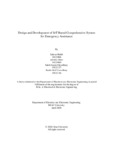| dc.contributor.advisor | Mohsin, Abu S.M. | |
| dc.contributor.author | Habib, Sahriar | |
| dc.contributor.author | Afnan, Zawata | |
| dc.contributor.author | Chowdhury, Sakib Anam | |
| dc.contributor.author | Chowdhury, Sarah Altaf | |
| dc.date.accessioned | 2021-03-21T06:48:55Z | |
| dc.date.available | 2021-03-21T06:48:55Z | |
| dc.date.copyright | 2020 | |
| dc.date.issued | 2020-04 | |
| dc.identifier.other | ID: 16121066 | |
| dc.identifier.other | ID: 16121060 | |
| dc.identifier.other | ID: 19121157 | |
| dc.identifier.other | ID: 19121156 | |
| dc.identifier.uri | http://hdl.handle.net/10361/14364 | |
| dc.description | This thesis is submitted in partial fulfillment of the requirements for the degree of Bachelor of Science in Electrical and Electronic Engineering, 2020. | en_US |
| dc.description | Cataloged from PDF version of thesis. | |
| dc.description | Includes bibliographical references (pages 104-106). | |
| dc.description.abstract | For any society to make significant unabridged progress, it is imperative to utilize technical
skills or otherwise, and ensure personal safety before anything else. This includes reducing the
time of response to an accident to the minimum, among other things. The development of the
Internet of Things (IoT) Based Emergency Response system is an attempt towards minimizing
the response time of essential emergency services such as ambulance services provided by
hospitals and fire stations and police services. By approaching this issue, we are also hoping to
reduce rates of casualty and injuries occurring to people involved in household fire and road
accidents in the longer run. The system is fully automated to be able to send emergency
notifications to nearby hospital, police station or fire station and an emergency contact in case
of an accident. This is done via a combination of a device that has to be installed in the vehicle
or/and in the home of the consumer and a remote server system that responds to the device
accordingly. The motive is to provide the live location of the accident and measure the severity
of the damage caused so that the appropriate degree of help can be provided as fast and
efficiently as possible using routes with the lowest traffic congestion. We believe this system
will reduce the response time of service providers after accidents and, in the process, bring
down casualty rates in a society. | en_US |
| dc.description.statementofresponsibility | Sahriar Habib | |
| dc.description.statementofresponsibility | Zawata Afnan | |
| dc.description.statementofresponsibility | Sakib Anam Chowdhury | |
| dc.description.statementofresponsibility | Sarah Altaf Chowdhury | |
| dc.format.extent | 115 pages | |
| dc.language.iso | en_US | en_US |
| dc.publisher | Brac University | en_US |
| dc.rights | Brac University theses are protected by copyright. They may be viewed from this source for any purpose, but reproduction or distribution in any format is prohibited without written permission. | |
| dc.subject | IoT | en_US |
| dc.subject | Accident detection | en_US |
| dc.subject | IoT Fire Alarm | en_US |
| dc.subject | Emergency response to an accident | en_US |
| dc.subject | IoT System | en_US |
| dc.title | Design and development of IoT based comprehensive system for emergency assistance | en_US |
| dc.type | Thesis | en_US |
| dc.contributor.department | Department of Electrical and Electronic Engineering, Brac University | |
| dc.description.degree | B. Electrical and Electronic Engineering | |

